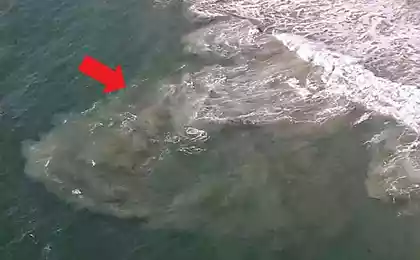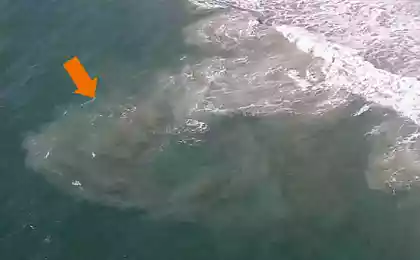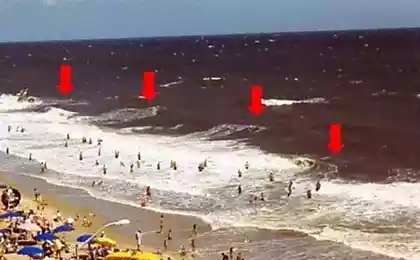448
This natural phenomenon takes hundreds of lives each year, but few know about it
Many people who swim well or pretty well on the water, don't understand how you can drown at the beach. Upon hearing the news in the holiday season tourists, "died near the coast", they think that the victim either could not swim or were in a state of alcoholic intoxication.
But the reason is quite different. It is a very dangerous but little-known phenomenon – a pneumatic movements, which are often also called "tsunami" and "rip" (eng. – rip current). They exist in all corners of the globe – in the Gulf of Mexico and the Black sea, and on the island of Bali. With them can handle not only ordinary people but also the excellent swimmers because I just don't know how to behave. Everything happens suddenly: so you sailed from the shore, then turned back, but nothing happens... You're struggling, but staying in the same place or even further removed. Still unsuccessful, the forces at the end and you are close to panic…
Ninety nine million five hundred five thousand one hundred sixty two
For starters, it is important to understand the principle of operation of Ripa. This type of marine and oceanic currents directed at right angles to the shore and formed in the process of discharge flow prilissa of water in the sea. The most dangerous are the pneumatic flow in shallow seas with a gently sloping beach, which is framed by sandbanks, a spit and the Islands (the sea of Azov, etc.). In these places, during low tide the return of the mass of water in the sea is impeded by sand bars. The water pressure at the narrow Strait that connects the sea with the estuary, increases dramatically. As a result, a rapid stream, through which water is moving at a speed of 2.5–3.0 m/s.
Schematically it looks like this:
reverse current into the sea perpendicular to the shore:
Seventy nine million two hundred ninety one thousand nine hundred forty
These "corridors" appear in different places at the coast during high tides. The waves go in and bring the water body, and then with different speed go in the sea or ocean, forming a reverse current. Usually the narrow corridor rip: 2-3 meters with a velocity of 4-5 km/h Is not dangerous. However, there may be demolition of the current width to 50 meters and a length of 200-400 meters, with speeds up to 15 km/h! Rips of that length are rare, but still there. How do we determine this current, so it does not fall?
Pay attention to the following markings:
Visible channel of boiling water perpendicular to the shore. In the coastal zone there are areas with a different shade of water: for example, around all light blue or greenish, but some area are white. A plot of foam, some sort of marine vegetation, bubbles, which is steadily moving away from shore into the open sea. In a continuous band of tidal waves has a 5-10 meter gap. If you see something described, consider yourself lucky and just don't go swimming in this place. But do not forget that 80% of spontaneous rips threat does not manifest itself visually. Liner currents occur near the shore. That is, even if you are standing in water waist-deep, and even more so at the chest, you can grab it rip and be in the sea. But just those who do not know how to swim, do so — just standing in the water and enjoy. So don't swim alone and don't ignore red flags and signs on the beach.
Eighty three million ninety eight thousand six hundred ninety two
The most important point:
How to behave to those who got into this for? Rules of conduct in a pneumatic flow:
1. Overcome panic! Brace yourself, because the people who know rules of conduct in a rip, saved in 99% of cases.
2. Save your strength! No need struggling to paddle against the current, wasting energy. No need to go to the beach and to the side, parallel to the beach. If rip narrow (5 meters), you will very quickly get out of it.
3. Analyze! If you are rowing according to the rules – to the side, and escape is not possible, then rip wide (20 meters and more). Then just stop wasting time and panic! Reverse current is usually short-lived and after 3-4 minutes it will stop. After this, put out 50-100 metres to the side, and then come back with the rest on the shore.
Thirty eight million three hundred eleven thousand nine hundred fifty two
It is important to consider and remember the following:
1. Rip will not pull you to the bottom. It's not the vortex not the vortex. Often cutting short and moving only the top layer of water that pulls from the shore along the surface, but not deep!
2. Rip is not very wide. Its width does not exceed 50 metres. And in most cases is only 10-20 meters. As a result, swam along the shore literally 20-30 meters, you will notice that swam out of the rip.
3. The length of the rip is limited. For quite quickly waning, "Tyagun" loses its force where the waves peak and begin to break. On surf slang it's called "line up" (line up). There's going to all the surfers, preparing to conquer the coming wave. Typically it is located no further than 100 metres from the shore. published
P. S. And remember, only by changing their consumption — together we change the world! ©
Source: fit4brain.com/8929
But the reason is quite different. It is a very dangerous but little-known phenomenon – a pneumatic movements, which are often also called "tsunami" and "rip" (eng. – rip current). They exist in all corners of the globe – in the Gulf of Mexico and the Black sea, and on the island of Bali. With them can handle not only ordinary people but also the excellent swimmers because I just don't know how to behave. Everything happens suddenly: so you sailed from the shore, then turned back, but nothing happens... You're struggling, but staying in the same place or even further removed. Still unsuccessful, the forces at the end and you are close to panic…
Ninety nine million five hundred five thousand one hundred sixty two
For starters, it is important to understand the principle of operation of Ripa. This type of marine and oceanic currents directed at right angles to the shore and formed in the process of discharge flow prilissa of water in the sea. The most dangerous are the pneumatic flow in shallow seas with a gently sloping beach, which is framed by sandbanks, a spit and the Islands (the sea of Azov, etc.). In these places, during low tide the return of the mass of water in the sea is impeded by sand bars. The water pressure at the narrow Strait that connects the sea with the estuary, increases dramatically. As a result, a rapid stream, through which water is moving at a speed of 2.5–3.0 m/s.
Schematically it looks like this:
reverse current into the sea perpendicular to the shore:
Seventy nine million two hundred ninety one thousand nine hundred forty
These "corridors" appear in different places at the coast during high tides. The waves go in and bring the water body, and then with different speed go in the sea or ocean, forming a reverse current. Usually the narrow corridor rip: 2-3 meters with a velocity of 4-5 km/h Is not dangerous. However, there may be demolition of the current width to 50 meters and a length of 200-400 meters, with speeds up to 15 km/h! Rips of that length are rare, but still there. How do we determine this current, so it does not fall?
Pay attention to the following markings:
Visible channel of boiling water perpendicular to the shore. In the coastal zone there are areas with a different shade of water: for example, around all light blue or greenish, but some area are white. A plot of foam, some sort of marine vegetation, bubbles, which is steadily moving away from shore into the open sea. In a continuous band of tidal waves has a 5-10 meter gap. If you see something described, consider yourself lucky and just don't go swimming in this place. But do not forget that 80% of spontaneous rips threat does not manifest itself visually. Liner currents occur near the shore. That is, even if you are standing in water waist-deep, and even more so at the chest, you can grab it rip and be in the sea. But just those who do not know how to swim, do so — just standing in the water and enjoy. So don't swim alone and don't ignore red flags and signs on the beach.
Eighty three million ninety eight thousand six hundred ninety two
The most important point:
How to behave to those who got into this for? Rules of conduct in a pneumatic flow:
1. Overcome panic! Brace yourself, because the people who know rules of conduct in a rip, saved in 99% of cases.
2. Save your strength! No need struggling to paddle against the current, wasting energy. No need to go to the beach and to the side, parallel to the beach. If rip narrow (5 meters), you will very quickly get out of it.
3. Analyze! If you are rowing according to the rules – to the side, and escape is not possible, then rip wide (20 meters and more). Then just stop wasting time and panic! Reverse current is usually short-lived and after 3-4 minutes it will stop. After this, put out 50-100 metres to the side, and then come back with the rest on the shore.
Thirty eight million three hundred eleven thousand nine hundred fifty two
It is important to consider and remember the following:
1. Rip will not pull you to the bottom. It's not the vortex not the vortex. Often cutting short and moving only the top layer of water that pulls from the shore along the surface, but not deep!
2. Rip is not very wide. Its width does not exceed 50 metres. And in most cases is only 10-20 meters. As a result, swam along the shore literally 20-30 meters, you will notice that swam out of the rip.
3. The length of the rip is limited. For quite quickly waning, "Tyagun" loses its force where the waves peak and begin to break. On surf slang it's called "line up" (line up). There's going to all the surfers, preparing to conquer the coming wave. Typically it is located no further than 100 metres from the shore. published
P. S. And remember, only by changing their consumption — together we change the world! ©
Source: fit4brain.com/8929
Emotional blackmail: not a crook from the street is a "native, close, favorite" people
Life After Death: What Does the Unbiased Science Say About the Soul?























